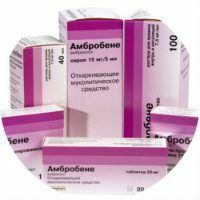
Acute and chronic respiratory diseases are often accompanied by difficulties in the formation and expectoration of sputum, which leads to severe bronchospasm and painful cough. To treat such conditions, Ambrobene is often prescribed, which liquefies the mucus in the bronchi and facilitates the excretion of sputum. There are several medicinal forms of the drug, but the most safe and effective in use, especially for children, is the inhalation solution.
- Composition and dosage
- Indications
- Contraindications
- Side effects
- How to do
- For children
- In pregnancy
- Analogues
Composition and dosage
Ambroxone is an active substance Ambrobene and belongs to the group of secretolytic( mucolytic) agents. Has a strong expectorant and secretory effect, is a metabolite( a product of transformation in the body) of bromhexine. Since 2012, is on the list of essential medicines.
Ambroxol is one of the most commonly used mucolytics in medical practice. It promotes the removal of a viscous secretion from the respiratory tract, thereby facilitating the cough of the patient. It stimulates the production of disintegration of the surfactant, increasing its secretion and stopping its decay, thereby preventing the penetration of pathogenic microorganisms into the epithelial cells.
Dosages for inhalation Ambrobene:
- for children under 2 years of inhalation are conducted with 1 ml of the drug 1-2 times per day;
- children aged 2 to 6 years are shown inhalation of 2 ml of solution 1-2 times a day;
- for adults and children over 6 years of inhalation are conducted with 2-3 ml of solution 1-2 times a day.
Indications
Diseases and conditions in which treatment is possible Ambroben:
- Colds accompanied by cough.
- Acute and chronic bronchitis.
- Bronchoectatic disease.
- Obstructive pulmonary disease.
- Prophylaxis of congestive phenomena in the bronchi.
- Chronic nonspecific lung diseases.
- Inflammation of the lungs.
- Cystic fibrosis.
- Bronchial asthma with difficulty in sputum discharge( inhalation can be done only after taking drugs that relieve spasm).
- Respiratory distress syndrome in premature and newborn children.
Contraindications
- First trimester of pregnancy.
- Hypersensitivity to individual components of the drug.
Pregnant women in the second and third trimester, during lactation, patients with excessive sputum production and disorders of bronchial motility, acute ulcer of the stomach and duodenum Ambrobe is used with caution under the supervision of a doctor.
The same applies to patients with liver disease or renal dysfunction - there should be significant intervals between taking the drug or its doses should be reduced.
It is not recommended to combine this drug with antitussive drugs, which could make it more difficult to withdraw phlegm.
Side effects of
- Frequent nausea, dryness of the throat and mucous membranesmouth, vomiting, abdominal pain, dyspepsia, infrequent diarrhea.
- Hypersensitivity reactions are infrequent.
- Disorders of gustatory perception - often.
- Allergic reactions - anaphylactic reactions, rash, itching, angioedema, hives, anaphylactic shock.
In very rare cases, skin reactions have been observed to take the drug in severe form, such as Lyell's syndrome or Stevens-Johnson syndrome. If the patient has noticed changes in the skin, it is necessary to stop using the drug and without fail to consult a doctor.
to contents ^How to do
When using the Ambrobene solution for inhalations, it is necessary to use special equipment( nebulizers, inhalers, except for steam ones).
Before the procedure, it is necessary to mix the preparation with 0.9% sodium chloride solution( saline solution) so that the air is optimally moistened, you can dilute 1: 1 and warm the mixture to body temperature. To avoid the occurrence of coughing, inhalations are carried out in the mode of normal breathing.
to table of contents ^For children
Inhalation treatment Ambrobene in children is performed from the very youngest age, although such procedures have a general restriction on this type of treatment for 2 years. During treatment, it is important to remember that there are acceptable daily dosages of Ambrobene for small patients, taking into account its oral intake, as well as any products containing ambroxol:
- for children up to 2 years of age - up to 15 mg per day;
- from 2 to 6 years daily rate - up to 30 mg;
- for children over 6 years of age the daily norm is up to 45 mg.
During pregnancy,
Animal studies have shown that Ambroxol penetrates into breast milk, so the use of the drug for women during the period of feeding is only possible according to the purpose of the specialist.
to contents ^Analogues
Trade names of preparations with active substance Ambroxol: Ambroxal, Ambroxol, Ambrosol, Ambrosan, Ambroxol, Bronhoxol, Bronhoval, Lazolvan, Lazolvan retard, Mucobron, Medox, Neo-Bronchol, Flavamed, Suprima-kof, Remebroks, Halixol, Fervex from a cough, Lazolangin, Dephlegmine.
